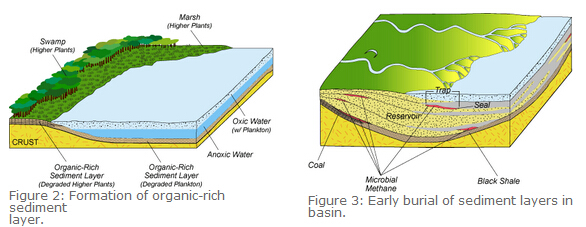托福分数测试HOT
托福课程优惠HOT
托福正价课试听0元
新托福机考练习NEW
0元讲座HOT
新版托福入门课程HOT
托福入门导学NEW
4000人报
托福机经
PDF版
TPO练习
官方授权
资料下载
826套
专业测评
40118人已测
高分经验
1193帖

扫码免费领资料
托福全科备考资料
免费水平测试及规划

扫码关注掌握一手留学资讯
回复XDF免费水平测试
As these organic-rich sediment layers are buried by deposition of overlying sediments in the subsiding basin, the sediments are compressed and eventually lithified into rocks referred to as black shale, bituminous limestone, or coal. Methane producing microorganisms referred to as methanogens may thrive under certain favorable conditions within the organic-rich sediment layer during its early burial. These microorganisms consume portions of the organic matter as a food source and generate methane as a byproduct. This methane, which is typically the main hydrocarbon in natural gas, has a distinct neutron deficiency in its carbon nuclei (i.e., carbon isotopes), which allows microbial natural gas (a.k.a., biogenic gas) to be readily distinguished from methane generated by thermal processes (a.k.a., thermogenic gas) later in a basin's subsidence history. The microbial methane may remain in the organic-rich layer or it may bubble up into the overlying sediment layers and escape into the ocean waters or atmosphere. If impermeable sediment layers, called seals, hinder the upward migration of microbial gas, the gas may collect in underlying porous sediments, called reservoirs (Figure 3).

basin.
Economically significant accumulations of microbial natural gas have been estimated to account for 20 percent of the world’s produced natural gas. Microbial methane may remain trapped in the organic-rich sediment layer through out its lithificaton and contribute to economic accumulations referred to as coal-bed methane and shale gas.
Burial of the organic-rich rock layer may continue in some subsiding basins to depths of 6,000 to 18,000 feet (1830 to 5490 m).At these depths, the organic-rich rock layer is exposed to temperatures of 150 to 350 ºF (66 to 177 ºC) for a few million to tens of millions of years. The organic matter within the organic-rich rock layer begins to cook during this period of heating and portions of it thermally decompose into crude oil and natural gas (i.e., thermogenic gas) (Figure 4).
This overall process of cooking petroleum out of an organic-rich rock layer involves the appropriate combination of temperature and time and is referred to as thermal maturation. If the original source of the organic matter is mostly higher plants (e.g., trees, shrubs, and grasses), natural gas will be the dominant petroleum generated with lesser amounts of crude oil generation. If the original source of the organic matter is plankton (e.g., algae, copepods, and bacteria), crude oil will be the dominant petroleum generated with lesser amounts of natural gas generation. Organic-rich rock layers that have undergone this process of petroleum generation are considered to be thermally mature and referred to as source rocks.
Organic-rich rocks that have not been thermally matured are referred to as being thermally immature. These immature organic-rich rocks may be referred to as oil shale if artificial heating at high temperatures (~1000ºF/~538ºC) in surface or near-surface reactors (a.k.a., retorts) yield economic quantities of oil. Oil shale retorting occurred in Scotland between 1860 and 1960 and is currently active in Estonia and Brazil.

 资料下载
资料下载
2021-2025托福机经试题|答案|范文下载
发布时间:2024-02-21关注新东方在线托福
回复【XDF】获取
托福全科备考资料大礼包
发布时间:2024-02-21关注新东方在线托福
回复【XDF】获取
托福正价课试听课程包
发布时间:2024-02-21关注新东方在线托福
回复【XDF】获取
托福定制备考规划
发布时间:2024-02-21关注新东方在线托福
回复【XDF】获取
托福TPO免费模考
发布时间:2024-02-21关注新东方在线托福
回复【XDF】获取
托福免费水平测试
发布时间:2024-02-21关注新东方在线托福
回复【XDF】获取
托福写作新题型模拟题+范文汇总[ETS发布]
发布时间:2023-07-30关注新东方在线托福
回复【XDF】获取
2023全年托福机经PDF版下载
发布时间:2023-06-17关注新东方在线托福
回复【XDF】获取
2022全年托福机经PDF版下载
发布时间:2023-06-17关注新东方在线托福
回复【XDF】获取
2022全年写作托福机经整理
发布时间:2023-01-13关注新东方在线托福
回复【XDF】获取
2022年托福考后题目回忆
发布时间:2023-01-13关注新东方在线托福
回复【XDF】获取
托福口语黄金80题附录音
发布时间:2023-01-13关注新东方在线托福
回复【XDF】获取
新东方IBT写作网络课堂录音[.rar]
发布时间:2023-01-13关注新东方在线托福
回复【XDF】获取
21天托福听力提升计划
发布时间:2023-01-13关注新东方在线托福
回复【XDF】获取
不怕跑题偏题,这份写作资料请收好
发布时间:2023-01-13关注新东方在线托福
回复【XDF】获取
托福阅读提分技巧锦囊妙计
发布时间:2023-01-13关注新东方在线托福
回复【XDF】获取
口语拖后腿?因为你缺少这套万能句式资料
发布时间:2019-11-01关注新东方在线托福
回复【XDF】获取
攻破托福听力难关的资料包
发布时间:2023-01-13关注新东方在线托福
回复【XDF】获取
看剧学英语,经典美剧一键获取
发布时间:2019-11-01关注新东方在线托福
回复【XDF】获取
原版外刊资源合集|精心打包整理
发布时间:2019-11-01关注新东方在线托福
回复【XDF】获取

关注新东方在线托福,
回复【XDF】获取大礼包

 推荐阅读
推荐阅读
托福考试网整理了2024托福考试时间、托福考试内容、托福写作新题型样题+范文、托福考题等内容,今天带来的是ETS官方托福阅读模拟题【2】,希望对同学们托福考试有所帮助!
托福考试网整理了2024托福考试时间、托福考试内容、托福写作新题型样题+范文、托福考题等内容,今天带来的是ETS官方托福阅读模拟题【1】,希望对同学们托福考试有所帮助!
托福考试网为大家整理了2024年托福阅读评分标准、托福阅读考试时间、托福阅读备考攻略等内容,今天给大家带来的是2024年1月托福考试考前刷题:阅读题(4),供大家参考!
托福考试网为大家整理了2024年托福阅读评分标准、托福阅读考试时间、托福阅读备考攻略等内容,今天给大家带来的是2024年1月托福考试考前刷题:阅读题(3),供大家参考!
托福考试网为大家整理了2024年托福阅读评分标准、托福阅读考试时间、托福阅读备考攻略等内容,今天给大家带来的是2024年1月托福考试考前刷题:阅读题(2),供大家参考!



 资料下载
资料下载
关注新东方在线托福
回复【XDF】获取
关注新东方在线托福
回复【XDF】获取
关注新东方在线托福
回复【XDF】获取
关注新东方在线托福
回复【XDF】获取
关注新东方在线托福
回复【XDF】获取
关注新东方在线托福
回复【XDF】获取
关注新东方在线托福
回复【XDF】获取
关注新东方在线托福
回复【XDF】获取
关注新东方在线托福
回复【XDF】获取
关注新东方在线托福
回复【XDF】获取
关注新东方在线托福
回复【XDF】获取
关注新东方在线托福
回复【XDF】获取
关注新东方在线托福
回复【XDF】获取
关注新东方在线托福
回复【XDF】获取
关注新东方在线托福
回复【XDF】获取
关注新东方在线托福
回复【XDF】获取
关注新东方在线托福
回复【XDF】获取
关注新东方在线托福
回复【XDF】获取
关注新东方在线托福
回复【XDF】获取
关注新东方在线托福
回复【XDF】获取

 阅读排行榜
阅读排行榜
 相关内容
相关内容